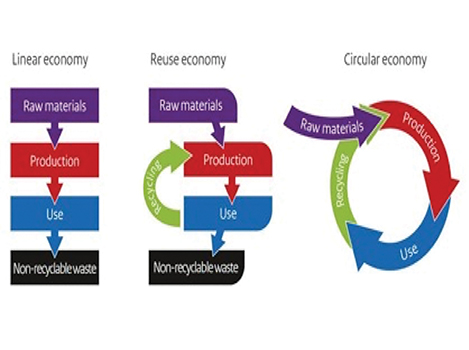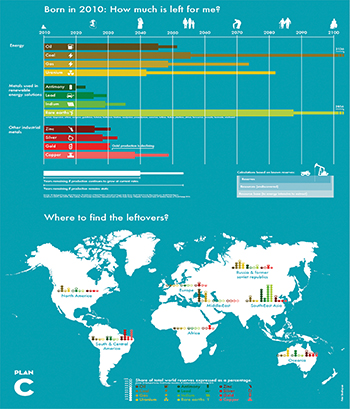Circular Economy adding to our Sustainability Bucket
By Dr. Sunnanda Panda, RevLog Resources
Supply chain has been evolving over the years, from forward logistics to reverse logistics; supply chain management then closed loop supply chain and now Circular Economy. Multiple terminologies have cropped up but the essence was - first the emphasis was to produce products and make it available to customers, back then resources were in abundance so our thinking never ventured conservation, but as production increased to match the increasing population and resources didn’t grow at the same pace, we started looking at sustaining resources! Circular economy has come into the spotlight in the recent years as such a tool to address waste and depletion of resources. With companies becoming more aware of the impacts they have on the environment and society, they are looking to recover their products and improve the circularity within the supply chain.
A circular economy is an alternate to the standard linear economy (make, use, dispose) during which we have a tendency to keep resources in use for as long as possible, extract the utmost worth from them while in use, then recover and regenerate merchandise and materials at the end of their service life. A circular economy is a regenerative system in which resource input and waste, emission and energy leakage are minimized by slowing, closing and narrowing energy and material loops; this can be achieved through enduring design, maintenance, repair, reuse, remanufacturing, refurbishing, recycling and upcycling.

From Linear to Circular Economy
The global population is expected to swell to 9 billion by 2050; we cannot afford to continue to exhaust finite resources. It’s not just about protecting the planet by reducing carbon emissions and the amount of trash ending up in landfills. We must also preserve resources to assure we can continue to produce enough goods to meet rising demands. Starbucks has built on their commitment to circular economy by pledging to eliminate plastic straws from their stores by 2020 and replacing them with a novel recyclable lid design. The coffee house giant was just the latest in an increasingly long line of corporation such as Phillips, H&M, Unilever, Renault, Nike and Google that have caste aside the linear “take, make and dispose” industrial model in favor of a more sustainable approach. Companies are designing products fully intending that when they reach the end of their lifecycle, they will be recovered and recycled and returned to use in a closed, waste- eliminating loop. Beyond regulatory pressures, many companies are embracing the circular economy for business benefits such cost saving from reused material as well as new business generated by delivering environmentally conscious products and services. For example, HP found that Millennials and Generation Z buyers in particular show a fair amount of interest in sustainable products and infact is a key factor in their purchasing decision. HP also experienced a 38 percent jump in their sales bids last year on deals where sustainability was required, and sustainable impact was an important factor behind at least $700 million of new revenue. Further Accenture is predicting that circular economy is gaining momentum and will unlock $4.5 trillion in new economic potential by 2030.
Companies should prepare for this emerging trend –1. “Why” embrace Circular Economy
The starting point for any circular economy effort is to ask, “Why should we do it?”
According to the World Business Council for Sustainable Development and BCG’s survey, in most cases the reasons for companiess to retool business operations to produce environmentally sensitive products that takes time, money and commitment but it also helps to acquire customers, strengthen existing relationships and operate in new markets. The last thing companies internal and external stakeholders want to appear as a“green wash” - a spin in which green PR is deceptively used to promote the perception that the organisation’s products, aims and policies are environmentally friendly. They should be actually meaningful to the customers and key stakeholders in their initiative on sustainability.

2. Endless Business Models
In the traditional linear model, products were produced and sold, after the sale the manufacturer hands over responsibility to the customer. From then on it’s the owners choice to maintain, dispose and ultimately replace it. But in the circular economy ownership is not a key consideration, companies undertake a product -service model where the customers can use the product through lease or pay-to-use arrangement rather than the conventional buy-to-own approach. Thus business do not limit their thinking to outdated business models rather they revamp to embrace new and more sustainable approaches which truly may be endless. Example- H&M foundation is rapidly progressing on ways to re-spin garments into new fibers.
3. Contemporary Supply Chain Opportunities
Companies using the old linear manufacturing model take resources from the planet, shape them into products, hold them in warehouses until they are ready to be shipped to customers across vast distances, each step involves cost, wastage and adversely affects the environment. While circular economy, disruptive technologies like 3D printing has shortened the supply chain, reduced carbon emission, eliminated waste and overstocking as production is brought closer to the consumption. These paths are long and complex but business payoffs may be substantial so companies must explore these opportunities early and commit to a more sustainable future.
The chart on page 18 estimates the number of years left before specific metals run out as shown in the infographics. Virgin metals like lead, zinc, silver and gold – may run out by 2020s, thus making recovery of materials from electronic products at the end of their life, of paramount importance.
Few interesting examples of circular economy solutions that prove to be sound business strategies, they also facilitate access to new markets, drive innovative solutions and save production costs.
Y Closet
Clothes are an everyday necessity and an important aspect of self-expression. With the habit of city working and increased socializing, there is greater demand on number of clothes and their variety, even retailer have responded by offering cheaper clothes in constantly changing styles. Between 2000- 2015, global clothing sales had doubled from 50 to 100 billion units while at the same time utilization rate - the number of times an item is worn in its lifetime has fallen on an average by 36%. More clothes are purchased and discarded earlier. Each second there is a truckload of clothes in landfills representing USD 460 billion of discarded value annually resulting in a huge lose of material, energy and water resources.
Y Closet, a Beijing based startup offered an alternative business model where customers pay a monthly subscription of $75 for which they can access up to 30 individual items selected from a catalogue of more than 150,000 different garments ranging from office, party and dating wear.
VIGGA
Another circular subscription concept, that offers high –quality children’s clothes for a monthly fee. The customers get 20 pieces of clothes in their child’s size, when the clothes are too small they are replaces by new set of clothes of a bigger size. Quality inspections are done for the clothes returned and then they are professional washed before giving it to the next child. Since multiple kids use these clothes the garments are of very high quality. This concept presents an incentive for the textile company to produce the highest quality clothes as possible. The higher the quality, the more children can use the same piece of clothes, the higher the profit, furthermore textile waste is reduce by 70-85%.
Levis Strauss
With around 24 billion pounds of clothing, shoes, textiles finding their way into US landfills every year – including untold tones of jeans – Levis’s is accepting old clothes and shoes of any brand and they are transformed into things such as insulation for buildings, cushioning material and new fibers for clothing with the help of its partner I:CO. Eventually they hope to recycle old Levis’ jeans into new ones.
Dell
In recognition of the rising e-waste epidemic, Dell has made inroads into circular economy initiatives by expanding its closed –loop recycled plastic supply chain and introduced the reclamation of carbon fiber source materials for some of its products. Two main objectives for Dell is to use 50 million pounds of recycled materials and recover 2 billion pounds of ewaste by 2020. Another innovative partnership announced by Dell with actress Nikki Reed’s jewellery company ‘Bayou with love’ which launched a new line of fine jewellery made using recycled gold from the motherboards of the end-of-life Dell computers.
GoMore
Cars are by far one of the most under-utilized resources in modern life. In Denmark, a car
transports 1.4 people by road and about 23 hours per day is spent in the parking space. The empty car seat is the largest excess capacity in the transport industry, a huge inefficiency having a negative impact on the environment. GoMore’s was established in 2005 and offered a service that enables drivers to invite people for rides on an already planned journey. This increases the number of people in cars and reduces the number of cars on the street, making car trips more efficient and better for the environment.
Timberland
The tire and footwear industry are the two largest user of virgin rubber. Timberland in partnership with tire manufacturer and distributor Omni United produce footwear outsoles from recycled tires that have reached the end-of –life on the road. This collaboration ensures that fewer tires are used for fuel or end-up in landfills. These tires are shipped to a North American recycling facility where it is made into crumb rubber and then crumb rubber is processed into rubber sheets which is shipped to Timberland who mixes it into a compound to produce outsoles for their boots and shoes.
Energizers
180,000 tons of batteries end up in US landfills every year, as they are very difficult to recycle due to their complicated chemistry of hazardous materials. Energizer’s has made a breakthrough into the recycling of batteries by recycling 4 percent of their products… though it may seem like a very small figure but it took the company eight years to achieve this.
LanzaTech
Steel manufacturing, oil refining and chemical industries all generate loads of carbon during their production. This waste carbon in LanzaTech’s value chain is carbon –rich waste that is converted into valuable fuel and chemical products by microbes in a gas fermentation process using a patented microbe technology. This process captures and recycles the waste gases before they are released as greenhouses gases. They reduce pollutants and particular emission by over 85 percent and also drive economic growth.
Rematch
Rematch has patented the state-of-the-art technology for separating worn-out artificial turf into rubber granules, sand and plastic fibres as raw and clean components that are then re-used and recycled by the turf industry and other industries. The technology is so efficacious that almost 100 percent of the components are either reused and recycled. They handle more than 40,000 tons of worn-out synthetic turf yearly, generating clean separated materials which are used for new soccer pitches worldwide.
So looking to the future, companies must create closed-loop recycling programs which make them distinct from the others. Infact it extends their product lifecycle, creates new industries, more jobs, and finally a more sustainable economy. Driving a culture to recycle in communities in the world represents new frontiers for organisations.
 Dr. Sunnanda Panda
Dr. Sunnanda PandaDr. Sunnanda Panda, logistics professional with a PhD in reverse Logistics. Founder and CEO of RevLog Resources, India.